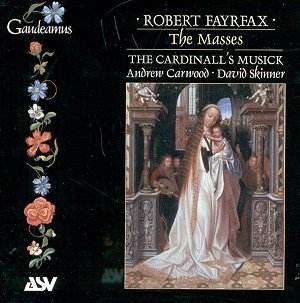Letís not beat about the bush. These are magnificent
discs containing sumptuous examples of early Tudor polyphony presented
in first class performances.
These recordings were made over a span of some 2 Ĺ
years and were originally issued by ASV on five single CDs. Originally
each disc contained one mass accompanied by other pieces by Fayrfax
including antiphons directly related to the mass setting in question.
Collectors who buy this set will therefore miss out in terms of completeness
but they need not feel they are being short changed for what we have
on these discs is a feast of Tudor polyphony in performances which could
scarcely be bettered. Moreover, as we shall see, the present issue includes
a "bonus" not originally contained in the first release.
Who was Robert Fayrfax? As David Skinner tells us in
his admirable notes (which are scholarly and comprehensive but eminently
readable), it is thought that he was born in rural Lincolnshire in 1464.
His early life is rather obscure but by December1497 he is recorded
as being one of the Gentlemen of the Chapel Royal. In this capacity
he sang at a number of important royal occasions including the coronation
of Henry VIII in 1509. In addition to this royal appointment he was
connected with St. Albanís Abbey and is believed to have been Informator
chori there from at least 1511.It may well be that the Missa Albanus
was written for the Abbey (certainly the title is suggestive).
The five masses here recorded represent the surviving
compositions by Fayrfax in this genre. Each consists of settings of
the Gloria, Credo, Sanctus./Benedictus and Agnus Dei. There exist two
manuscript sources for the music, one of which is the Lambeth Choirbook.
This was likely to have been in use at Arundel College, Sussex after
ca1524. Fittingly these recordings were made in what was then the chapel
of that college, now a part of the Castle. The engineers have captured
the sound of the choir most truthfully within this lovely acoustic.
The membership of The Cardinallís Musick fluctuates
between the various recordings. The choral forces are broadly similar,
usually consisting of three each of sopranos, male altos, tenors and
basses. All but the Missa Albanus also uses three baritones.
The inclusion of female voices on the top line, while it may offend
die-hard purists seems to me entirely justified and successful. They
impart an ethereal purity to an ensemble which is excellently blended
throughout. The whole set is characterised by imaginative attention
to dynamic shading and Andrew Carwood, who conducts all the performances,
sustains the tension admirably. There is plenty of appropriate rhythmic
variety and the conclusions of the various Gloria and Credo settings
are particularly exultant and thrilling. Carwood is, of course, a well-known
singer himself and he imparts both a singerís understanding and a deep
knowledge of the music to the phrasing.
Within each mass the individual movements are beautifully
shaped and Carwood and his singers build arch after arch of polyphony
with consummate skill. All the strands of Fayrfaxís often complex writing
register well.
I mentioned a "bonus item". This is a short
elevation motet, recently discovered in a manuscript copy of the Missa
O bone Ihesu in Jena. The setting is incomplete, though not to
such an extent as to inhibit reconstruction. It has now been edited
for performance by David Skinner and is included very appropriately
within the Sanctus of this mass at the point where it would have been
heard in the liturgy. The piece is 145 bars long and, very enterprisingly
ASV print the full music within the booklet.
This issue is, I think, outstanding in every way. ASV
has given us spellbinding performances of timeless music recorded with
the utmost fidelity. As far as I am aware the music of Robert Fayrfax
had lain largely forgotten until Carwood and Skinner and their expert
singers brought it back to life with these invaluable recordings. In
their sensitive hands these compositions speak to us again nearly 500
years after they were first written.
A prodigious achievement, urgently recommended to all
those who care about the English choral tradition.
John Quinn

